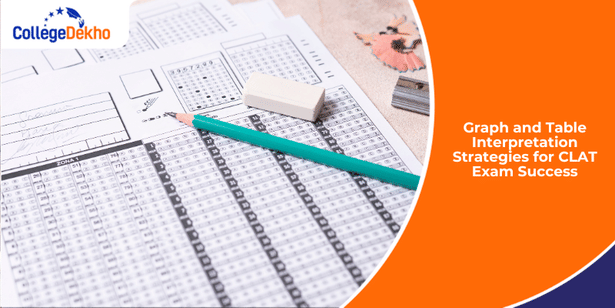
If you are preparing for the CLAT exam , you must be aware that the Quantitative Techniques section is a tough nut to crack. However, questions on Data Interpretation, which include tables, graphs, and statistics, can help you improve your overall score and confidence on exam day if tackled correctly. One thing you should keep in mind is that you will only be able to crack this section if you prepare for it well and also adhere to certain strategies and guidelines that will help you understand and answer graph and table interpretation questions effectively.
Also Read: Time Management Tricks for CLAT 2026 Exam
Useful Graph and Table Interpretation Strategies for CLAT 2026
There are numerous strategies and methods that you can incorporate in your CLAT Data Interpretation preparation. We have mentioned some of the most useful strategies that will help you tackle most types of DI questions in CLAT below:
Strategy | Explanation | How it Helps in CLAT |
|---|---|---|
Break Complex Data into Parts | Divide tables/ graphs into smaller chunks. | Reduces overwhelm and improves focus on key details. |
Compare Categories Smartly | Focus on relative differences (ratios, percentage change). | Saves time by avoiding unnecessary calculations. |
Cross-Check with Question | Always re-read the exact requirement (sum, average, %). | Prevents answering irrelevant parts of the data. |
Estimate Before Calculating | Approximate values to get a quick sense of answers. | Helps eliminate wrong options in MCQs faster. |
Identify Data Type | Understand whether it is a percentage, a ratio, an absolute number, or a trend. | Helps in choosing the right calculation approach. |
Look for Trends & Patterns | Spot increases, decreases, plateaus, or sharp changes. | Quickly identifies main insights without calculating everything. |
Note Units & Scale | Check axis scales, currency, percentages, or population counts. | Avoids common mistakes like misreading “thousands” as “millions.” |
Read the Title & Labels First | Check what the graph/ table represents (units, categories, time frame). | Prevents confusion and misinterpretation of data. |
Stay Aware of Traps | Watch for overlapping categories, double-counting, or missing years/data. | Avoids falling into common exam-setter tricks. |
Use Elimination Method | Compare approximate calculations with answer choices. | Saves time by avoiding full calculations when not required. |
Best Books for CLAT Quantitative Techniques Preparation
In addition to the strategies mentioned above, you will also find new techniques and methods to solve DI and other Quant questions in CLAT from good study material like the ones mentioned below:
- Quantitative Aptitude (R.S. Aggarwal)
- Quantitative Aptitude Revised Edn 2025
- RS Aggarwal Combo: Quant + Reasoning
- Formulae & Tricks Quantitative Ability by Shweta Arora
- Quantitative Techniques by T. Balasubramanian
- Quantitative Techniques in Management (Vohra & Arora)
How to Use CLAT Quantitative Techniques Study Material
Check out the optimal way to use the best books available for CLAT Quantitative Techniques preparation below:
Stage | What to Do |
|---|---|
Foundation | Start with RS Agarwal / NCERT to build concept clarity. Make sure you understand all basic arithmetic, algebra, and number system concepts. |
Practice & Speed | Use books with large question banks (Aggarwal, Pearson, etc.) to practice under time. Also, use “formula & tricks” books for shortcuts. |
CLAT-Style Application | After basics, solve previous years’ CLAT quant questions + mock tests. Use books that have data interpretation / caselet style or include graph/ table questions. |
Revision | Go through advanced-level books, formula sheets, and revisit the NCERT summary of key formulas; solve sample papers focusing on weak areas. |
This was all about graph and table interpretation strategies for CLAT!. Check out the links below to learn more!
Related Articles:
For any admission-related guidance, call our toll-free number 1800-572-9877, or fill out our Common Application Form (CAF) . Stay tuned with CollegeDekho for more updates related to UG/PG admission and colleges!
Are you feeling lost and unsure about what career path to take after completing 12th standard?
Say goodbye to confusion and hello to a bright future!

FAQs
Yes, the approximation method is useful when solving CLAT Quant questions. Approximation and elimination are very useful to save time, especially when answer options are far apart.
In the CLAT Quantitative Techniques (QT) section, the graph and table-related questions usually form the majority. Around 70–80% of QT (≈ 8–12 questions) are graph, table, or caselet-based, and the remaining are direct arithmetic problems (percentages, averages, ratios, etc.).
The type of questions asked in the CLAT quant section mostly include data interpretation (tables, bar graphs, pie charts, caselets), along with arithmetic-based questions like percentages, averages, ratios, and profit & loss.
The weightage of Quantitative Techniques in CLAT is around 10% with 10-12 questions worth 13 to 17 marks in total. However, this section can significantly improve your overall score with scoring portions like Data Interpreation.
No, calculators are not allowed during the CLAT exam. You must practice mental maths and use techniques like Vedic maths to improve your calculations.
Was this article helpful?




















Similar Articles
Expected rank for 30 marks in SLAT 2026
UGC NET Law December 2025 Most Important Topics for Last Minute Revision
Expected rank for 40 marks in SLAT 2026
Expected rank for 50 marks in SLAT 2026
What is a Good Score in SLAT 2026?
Government Jobs after LLB